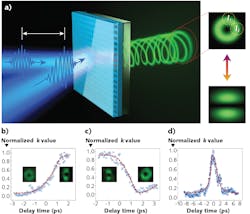Bound states in the continuum (BIC) microlasers reach ultrafast switching speeds

Scientists at Harbin Institute of Technology (Harbin, China), Australian National University (Canberra, ACT, Australia), and City University of New York (New York, NY) have applied the concept of bound states in the continuum (BIC) to microlasers, breaking the long-standing tradeoff between ultralow energy consumption and ultrafast switching.1
In past decades, requirements for all-optical switches have included low energy consumption, high speed, strong modulation ratio, small footprint, and on-chip integration. The small footprint and on-chip integration are quite easy for current nanotechnologies—however, the tradeoff between low energy consumption and high speed is a severe challenge. The conventional approach focuses on enhancing the light-matter interaction via on-chip integrated micro- or nanocavities. But while the relatively high Q factor of a resonator can effectively increase the local electromagnetic response, the corresponding increase in mode lifetime with increase in Q also restricts the response of the switch. And unfortunately, other methods with ultrasmall effective mode volume such as plasmonic nanostructures are limited by large coupling and propagation loss.
Bound states in the continuum
By focusing on laser emission from topologically protected BIC microlasers, the power/switching tradeoff can be addressed. Owing to the far-field characteristics of BIC lasers, the transition from BIC microlasers to conventional lasers represents a redistribution of the laser emission instead of direct on/off switching of the lasing mode. This means the switching process is not limited by the lifetime of the resonant mode.
Because the BICs can eventually have infinitely large Q factors, the laser thresholds can be reduced by orders of magnitude, making it possible to realize the ultrafast optical switching that match all the requirements of modern classic and quantum information.
In square-latticed MAPbBr3 perovskite periodic nanostructures, the researchers have realized single-mode laser emission with donut beam profiles. As expected, they have confirmed the relationship between the symmetry of the pumping profile and the emission beam profile. By applying the second beam with spatial and temporal deviation, the four-fold rotational symmetry of the square lattice is broken in a very short time and the BIC laser degrades to a conventional photonic-crystal laser with two linearly polarized lobes.
The transition process takes place in 1 to 1.5 ps; complete transition from a donut to two lobes and back to a donut has also been realized within 2 to 3 ps. Such switching times are more than an order of magnitude faster than the BIC microlaser lifetime, clearly demonstrating that the limitation of laser lifetime on the switching time is broken.
Presently, the team is working on the reduction of energy consumption and cascaded on-chip integration of the ultrafast switchable BIC lasers—a key step towards efficient optical and quantum computing.
REFERENCE
1. C. Huang et al., Science, 367, 1018–1021 (2020).
About the Author

Gail Overton
Senior Editor (2004-2020)
Gail has more than 30 years of engineering, marketing, product management, and editorial experience in the photonics and optical communications industry. Before joining the staff at Laser Focus World in 2004, she held many product management and product marketing roles in the fiber-optics industry, most notably at Hughes (El Segundo, CA), GTE Labs (Waltham, MA), Corning (Corning, NY), Photon Kinetics (Beaverton, OR), and Newport Corporation (Irvine, CA). During her marketing career, Gail published articles in WDM Solutions and Sensors magazine and traveled internationally to conduct product and sales training. Gail received her BS degree in physics, with an emphasis in optics, from San Diego State University in San Diego, CA in May 1986.